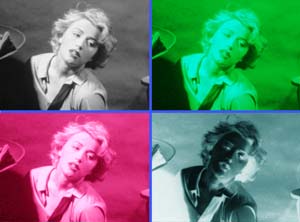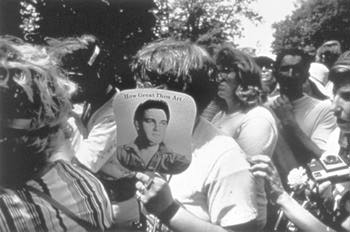
The Print and the Showgirl: In her 1982 untitled photograph, chameleon artist Cindy Sherman poses as Marilyn Monroe.
Traveling exhibit gives Elvis and Marilyn the high artistic treatment
By Zack Stentz
Elvis was a hero to most, but he never meant shit to me.
Public Enemy, "Fight the Power"
Like kissing Hitler.
Tony Curtis, on working with Marilyn Monroe in "Some Like It Hot"
ELVIS AND MARILYN. Despite recent attempts at idol-toppling like the ones above, they remain the archetypal masculine and feminine images of mid-century America, the lingam and yoni of our collective psychosexual landscape, muses to three generations of actors, songwriters and artists.
And just as lateSoviet era artists used the images of Lenin and Stalin they were force-fed in youth to examine and deconstruct the myths of the dying society the Socialist Realist figures represented, so have modern visual artists deployed Elvis and Marilyn as vehicles to deliver incisive critiques of the celebrity-obsessed culture they embody. One artist, Leonid Sokov, has even combined the two traditions in his garish, black-and-white depiction of a corpulent, sinister Stalin clutching at a dazed-looking Marilyn, like a crime boss with his moll.
Sokov's disturbing portrait is only one of the Marilyn and Elvis-themed works on display at Elvis + Marilyn: 2 x Immortal, the popular traveling art exhibit devoted to the pair that arrives at San Jose's Museum of Art on Nov. 24.
Despite the seemingly flippant subject matter, the 80-plus artists represented have serious concerns on their minds, and force the numbingly familiar visages of Presley and Monroe through a wide variety of political, intellectual and sexual filters, using them to entertainingly illuminate thorny questions of gender, class and power.
The territory on display ranges from the rather obvious, such as Kata's Elvis Was a Real Man, a painting of a neutered Elvis washing the dishes, to the disturbingly evocative, as with Marie Pobre's portrait, which imagines a wrinkled, 60-ish Marilyn as she might have looked had she lived into the 1980s. The latter says far more on the ephemeral nature of female desirability in American society than 10 Naomi Wolf books.
Other show standouts include Warhol's, Haring's and Christo's fairly straightforward Elvis and Marilyn portraits done in their distinctive styles, along with stranger, less-familiar offerings such as Buster Cleveland's morbid, skull-filled mixed-media Marilyn (with a J.F.K. silver half-dollar placed strategically in the corner for the symbol-impaired), Paul Karabinis' photo-collage vision of the King as an Ozymandias figure lying toppled in the desert, and Rena LaCaria's Diego Riveralike painting of Elvis as a nude, well-hung Adonis.
One favorite with both audiences and critics is the 7-foot-tall sculpture/assemblage/altar titled Homage to Elvis, by Mendocino County artist Joanne Stephens. When Elvis+Marilyn played New York, Homage garnered a full-color photo on the cover of the Sunday New York Times Arts and Leisure section.
The only Northern California artist in the show, Stephens was approached for inclusion by a friend of the show's curator, who spotted the King lurking amid a larger exhibit of Stephens' witty, often satirical assemblages. "I wasn't a great Elvis fan when I started work on the piece," Stephens confesses. "And I began very satirically, but I ended on a very sincere note."
Explaining the bond she ultimately felt with her subject, Stephens says, "This is someone who gave his all to his public, which is why I think he and Marilyn have survived into immortality, and what makes this show so interesting."
This quasi-religious aspect to Elvis and Marilyn prompted artist Kathleen Kondilas to superimpose Monroe's image onto a medieval Madonna-and-child painting in one of the show's eerier entries, and inspired one anonymous humorist to circulate a list on the Internet of comparisons between Presley and an earlier King of Kings. Examples: "Jesus was the Lord's shepherd--Elvis dated Cybill Shepherd. Jesus' father is everywhere--Elvis' father was a drifter, and moved around quite a lot."
"He's become almost this Christ sort of figure," agrees Stephens, "with people praying to him and writing these really incredible fan letters to him."

Saving Graceland: Robert Burns' series of photographs of Graceland captures the intensity of the King's fans.
Mouth of the South
TO ACCOMPANY the Elvis + Marilyn: 2 X Immortal show and make explicit some of the many undercurrents hinted at by the artists, Art Institute of Chicago instructor and Best of Elvis author Dr. Susan Doll will kick off the exhibit with a lecture Saturday (Nov. 23) titled "All Shook Up: Elvis Presley and his Southern Roots."
"My dissertation was on Elvis' Southernness," explains Doll, who has written a total of five books on Presley. "And it's a subject which I find very interesting, but usually it's too academic to include in my books."
She continues, "When you read the contemporary accounts of Elvis that ran in the national media when he first became famous--and I've read thousands--it's really interesting to see how prejudiced they were against him because of his Southernness. Because his hair was slicked back, they assumed it was dirty--because Southerners were supposed to be dirty. And they mocked his outrageous clothes by explaining that Southerners had no taste. And whenever they ran interviews with Elvis, they'd always spell his speech phonetically, to make fun of and draw attention to his accent."
Doll still finds vestiges of this anti-Southern, antiworking class snobbery in the media today, in how the press typically covers Elvis fans by stereotyping them as velvet paintingcollecting, trailer parkdwelling yokels.
"And when you go to Memphis for Elvis week in August, you see how that stereotype just isn't true," Doll says. "Though the media always seek those people out to interview them about Elvis."
And strangely, for someone who has devoted much of her academic career to studying the Elvis phenomenon, Doll didn't begin her studies as a Presley fan. "I was putting myself through school in the '70s by working in a truck stop," she recalls. "And when Elvis died in the summer of 1977, it just consumed the lives of the people I worked with for several weeks solid. And when I went back to school, a lot of people didn't even know Elvis was dead. That contrast between the two groups of people was really what started my work in that area."
As for the show's conceit of yoking together Presley and Monroe, Doll confesses to harboring mixed feelings, despite having herself written a book on Marilyn. "They were just such different people," she says. "I mean, there are parallels between them in terms of how they were both exploited by the machinery of pop culture, but that comparison is just so obvious that I don't find it very interesting.
"It's odd, though," she adds, "that the two never met each other, because they were both in Hollywood around the same time. And then he left to go into the Army, and she went off to Connecticut to live with Arthur Miller, also around the same time. But you never heard [Elvis] talk about her, the way he talked about other women who were working in Hollywood at the time."
Doll is currently working on another Presley-related tome, and with the 20th anniversary of Presley's death and the 35th of Monroe's both coming up in 1997, neither cult of personality shows any signs of slackening. And while Doll declines to speculate on the reasons for Marilyn's enduring appeal, she has no doubt as to why Presley remains such a powerful draw, nearly two decades after his undignified demise.
"It's because he went through so many different incarnations," she says. "He was a country singer, a rock singer, a movie star, a Southern boy, a Las Vegas performer and so many other things. And each of his personas spoke to a different group of people."
Doll's words even echo those of Mexican Elvis impersonator El Vez, who likes to assert that Presley, by virtue of his darkly handsome looks and underdog status, is an icon to Latino America, as well. "Yes," Doll agrees, "nearly everyone can identify with at least one aspect of Elvis."
Elvis + Marilyn: 2 X Immortal will be on display Nov. 24Feb. 23, 1997, at the San Jose Museum of Art. Susan Doll will deliver her lecture Sat., Nov. 23 at 4:30 p.m. Lectures are free to members, $6 general, $3 students/seniors.
[ Metro | Metroactive Central | Archives ]
![[Metroactive Arts]](/arts/gifs/art468.gif)